Managing Expense Entries
Expense Entry is located under Expense-->Standard Expense Entry (see figure
30.1).
Expense Entry allows you to input your business related expenses on a single
sheet. You can view your expenses for a single day or an entire period. Expense
Entry displays the period view by default. To enter expenses for a period, go
to Viewing by Period. To enter or view expenses for a different period,
you can use the Calendar in the login bar in the upper right corner to jump to a particular date. Alternatively,
you may use the Date Arrow Icons ( )
to move backward or forward one period at a time. To enter expenses for a single
day, go to Viewing by Day. To enter or view expenses for a different
day, you can use the Calendar in the login bar in the upper right corner to jump to a particular date. Alternatively,
you may use the Date Arrow Icons to move backward or forward one day at a time.
)
to move backward or forward one period at a time. To enter expenses for a single
day, go to Viewing by Day. To enter or view expenses for a different
day, you can use the Calendar in the login bar in the upper right corner to jump to a particular date. Alternatively,
you may use the Date Arrow Icons to move backward or forward one day at a time.

Figure 30.1. Expense Entry
Keep in mind that expense sheets are configurable by administrators so your expense sheet may vary in appearance and functionality from the one shown. For example, certain column headers in your expense sheet such as Project, Expense Code, Source, Currency and Comment may be hidden or may be renamed altogether.
Your administrator has already setup your expense sheet to let you log expenses
during a particular period or date range. Expense sheet periods are typically
a week, month, or pay period, depending on how your company prefers to track
expenses. To enter expenses or view expenses for a different period, you can
use the Calendar in the login bar in the upper right corner to jump to a particular date. Alternatively,
you may use the Date Arrow Icons ( ),
located at the top of the expense sheet around the date, to move backward or
forward one period at a time.
),
located at the top of the expense sheet around the date, to move backward or
forward one period at a time.
Standard expense sheets will typically let you select a Project, Expense Code, Source, and Currency. To create an
expense entry, select a value from each of the dropdowns shown on your expense sheet. You can also specify a Comment
for the expense entry, which may be required. Once you have made your selections, you can then specify the expense
amount for that project on a specific date.
If your administrator has allowed you to track your work-related mileage or distance traveled, you can track that mileage on the expense entry screen as well. If you select your mileage- or distance-enabled code from the Expense Code column on the expense entry screen, the amount field will change from accepting expense amounts to accepting mileage or distance amounts. While you are entering your distance amount, you will also be able to see the rate that will be applied to the distance. After you save the distance amount you have entered, the amount field will be converted to the expense amount based on the applicable rate. If you need to change the distance amount that was originally entered, you can do so by clicking on the field to change it. If you need to see what was entered as the distance amount, you can either hover over the entry or run an expense report with the Mileage field included in the report. NOTE TO ADMINISTRATORS: Expense Code values can be flagged as mileage or distance by creating an Expense Code Custom Field called "Mileage Expense" and setting the field to "Yes" for Expense Codes that should be entered as distance amounts. See Custom Fields and Mileage Conversions for more information on setting up the custom field and conversion rates for mileage/distance tracking.
To edit an expense entry on your expense sheet, click the Edit Icon ( )
to the left of the respective entry. This will refresh the screen and allow
you to change the Project, Expense Code, Source, and Currency. You may also
modify your Comment associated with the entry.
)
to the left of the respective entry. This will refresh the screen and allow
you to change the Project, Expense Code, Source, and Currency. You may also
modify your Comment associated with the entry.
To delete an expense entry from your expense sheet, you can simply click the
Delete Icon ( ),
a trash can, located to the right of the respective entry. The screen will refresh
with the expense entry having been deleted.
),
a trash can, located to the right of the respective entry. The screen will refresh
with the expense entry having been deleted.
When finished creating, editing, and removing expense entries, click the Save button.
Searching and Selecting Project
There are four ways to select a project when managing expense entries. You can use the expandable Project Tree, the Inline Tree in the Project dropdown, Project Search, or the My Projects List.
Your Journyx Administrator may have configured your system to not allow records to be changed without a
comment explaining the change. In such a case, the edit and delete icons will not be present. In this case, simply
click on the expense amount you wish to change, enter the new value and an appropriate note, and click Save.
Project Tree
The first method allows you to select a project from a hierarchical tree
that contains all the projects to which you have been granted access, as well
as some of the parent projects that are required for drilling down into the
hierarchy. To view the tree, click the Project Tree Icon ( ),
an arrow with a list, located to the left of the respective Project dropdown.
This will launch a pop-up window containing a navigable project tree with
expanding and collapsing nodes (see figure 30.2). To open a node and view
all child projects, click the expand node. To close a node and hide all child
projects, click the collapse node. When you have found the project that you
wish to log expenses to, select the project and then click the Done button.
This will close the pop-up window and the project you selected should appear
in the Project dropdown.
),
an arrow with a list, located to the left of the respective Project dropdown.
This will launch a pop-up window containing a navigable project tree with
expanding and collapsing nodes (see figure 30.2). To open a node and view
all child projects, click the expand node. To close a node and hide all child
projects, click the collapse node. When you have found the project that you
wish to log expenses to, select the project and then click the Done button.
This will close the pop-up window and the project you selected should appear
in the Project dropdown.
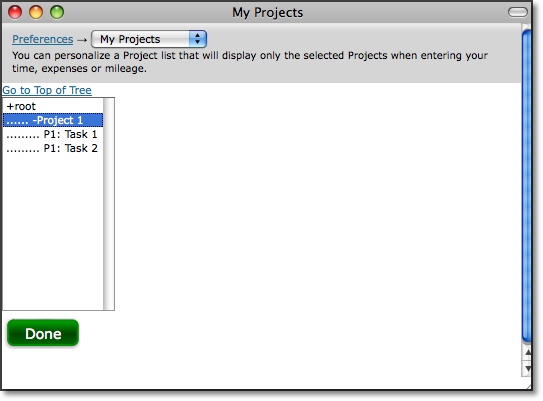
Figure 30.2. Project tree
Inline Tree in Dropdown
The second method allows you to drill down into the project hierarchy using
a project tree that is included in the project dropdown itself. If your administrator
has set up your expense sheet to include this option, you can navigate down
through the hierarchy of projects by clicking on selections directly in the
Project dropdown. After each selection, the next level in the hierarchy is
displayed. The final selection that is made prior to save determines the project
to which expenses will be logged.
Project Search
The third method allows you to specify search criteria and select a project
from the search results. To do a project search, click the Project Search
Icon ( ),
the magnifying glass, located to the left of the respective Project dropdown.
This will launch a pop-up window containing search criteria (see figure 30.3).
Specify the project name or description for the project that you are searching
for. As you type, you will see returned search results below the search criteria.
From the search results, you can select the project that you wish to log hours
for. When you select the project, the pop-up window will automatically close
and the project you selected should appear in the Project dropdown menu. Additional
search options can be selected by clicking on the arrow to expand the Search
Options table.
),
the magnifying glass, located to the left of the respective Project dropdown.
This will launch a pop-up window containing search criteria (see figure 30.3).
Specify the project name or description for the project that you are searching
for. As you type, you will see returned search results below the search criteria.
From the search results, you can select the project that you wish to log hours
for. When you select the project, the pop-up window will automatically close
and the project you selected should appear in the Project dropdown menu. Additional
search options can be selected by clicking on the arrow to expand the Search
Options table.
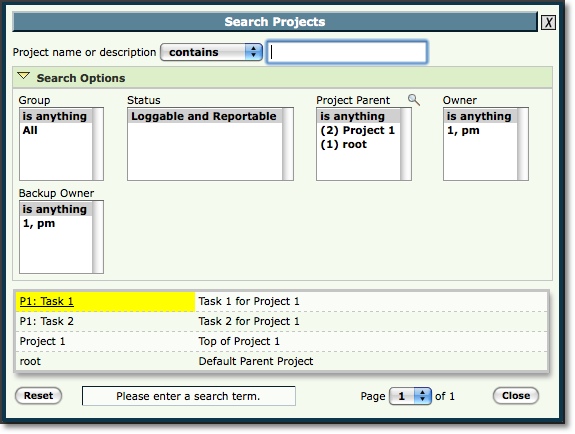
Figure 30.3. Project search
My Project List
You can maintain your own unique list of projects that will be displayed
by default in the project dropdown. This will keep you from having to routinely
search for or select a project from the project tree for projects that you
frequently log expenses to. The My Projects link, located at the bottom of
the timesheet will launch a pop-up window that can be used to add and remove
projects from your unique Project List (see figure 30.4). You may add projects
from the Available Projects list by selecting the project and clicking the
Add button. These projects will be added to your Project List shown in the
box to the right. To remove a project from your Project List, select the project
and click the Remove button. You also have the ability to add and remove all
projects to and from your Project List. When you are finished, click the Save
button.
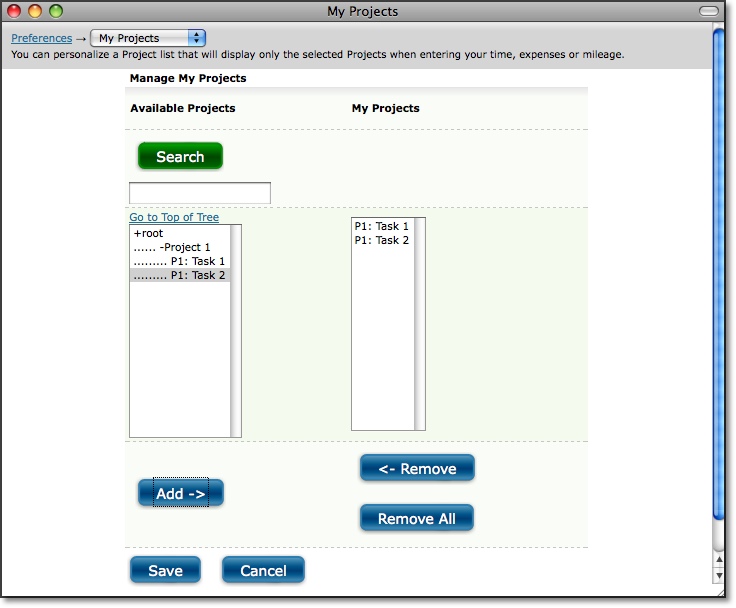
Figure 30.4. My Projects
Memorized Entries
Memorized Entries allow you to save your most common expenses so that you do not have to repeatedly select them when entering expenses. A Memorized Entry contains a single Project, Expense Code, Source, Currency, and Comment. After an entry has been memorized, it will appear in all your expense sheets thereafter. You then only need to specify the actual expense.
To create a Memorized Entry, select the appropriate Project, Expense Code,
Source, Currency, and Comment, and then click the Save button. You can only
create a Memorized Entry after that entry has been saved in your expense sheet.
After the entry has been saved, you will see the Memorize Icon ( ),
an embossed M, to the right of the entry. Click the Memorize Entry Icon, review
the contents of the entry as it is displayed on the User Memorized Entries screen,
and click Save to preserve the entry. The information in that entry will be
memorized, except the expense, and will appear in all your expense sheets thereafter.
You can also memorize part of an entry by using the wildcards feature. Selecting
the 'any' value from the appropriate dropdown will not memorize that field.
The same is true when leaving the Comment field blank.
),
an embossed M, to the right of the entry. Click the Memorize Entry Icon, review
the contents of the entry as it is displayed on the User Memorized Entries screen,
and click Save to preserve the entry. The information in that entry will be
memorized, except the expense, and will appear in all your expense sheets thereafter.
You can also memorize part of an entry by using the wildcards feature. Selecting
the 'any' value from the appropriate dropdown will not memorize that field.
The same is true when leaving the Comment field blank.
Alternatively, you may create a Memorized Entry by going to Expense-->Memorized Entries-->Create Memorized
Entry (see figure 30.5). Select a Project,
Expense Code, Source, Currency, and Comment. When finished, click the Save button.
The entry will be memorized and will appear in all your expense sheets.

Figure 30.5. Memorized Expense Entries
To manage existing Memorized Entries, go to Expense-->Memorized Entries-->Manage Memorized Entries. This screen will show you all the Memorized Entries that you have stored in the system. These are all the Memorized Entries that appear in your timesheets. You can change the Project, Expense Code, Source, Currency, and Comment for the respective Memorized Entry that you want to modify. When finished, click the Save button. To delete a Memorized Entry from your expense sheet, select the Memorized Entries to delete and click the Delete button.
Project Entry Notes
The system allows you to create Project Notes for any expense record within
an expense entry. Project Notes provide a way for you to record complex comments
and information for expenses logged to a project over the course of an expense
period. You can create a Project Note for a specific expense record by clicking
the Project Note icon ( ),
a small yellow note, located immediately to the right of a saved expense on
your expense sheet. Again, the expense entry must already be saved in the system
before you will see the yellow note appear. Clicking on the note will launch
a pop-up window, which can be used to create, edit, or delete Project Notes
(see figure 30.6).
),
a small yellow note, located immediately to the right of a saved expense on
your expense sheet. Again, the expense entry must already be saved in the system
before you will see the yellow note appear. Clicking on the note will launch
a pop-up window, which can be used to create, edit, or delete Project Notes
(see figure 30.6).
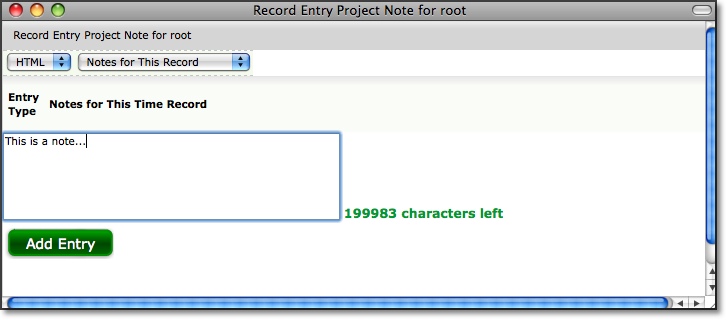
Figure 30.6. Project Notes
You can also manage Project Notes under Preferences-->Project Notes. You can view existing Project Notes by specifying the search criteria and date range and then clicking the Search button. The search results of Project Notes will be displayed below the criteria. To create a new Project Note, go to the 'Create a New Project Note' section. Select a Project and specify a note. When finished, click the Save button.
Sheet History
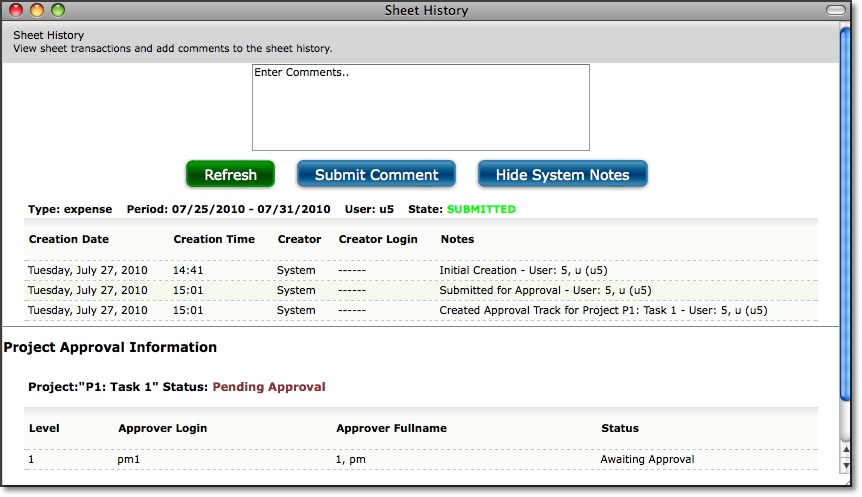
Figure 30.7. Sheet history
Sheet History contains notes regarding the expense sheet and the approval process
for that specific expense sheet. The Sheet History link is located in the Additional
Options section at the bottom of your expense sheet. Clicking the Sheet History
link will launch a pop-up window containing all the actions associated with
the expense sheet to date. You can insert a note in the sheet history (i.e.,
for approvers) by specifying the text in the available textbox and clicking
the Submit Comment button. To view more details click the Show System Notes
button. This will display the system notes that correspond to the actions associated
with the expense sheet. To hide the system notes, you can click the Hide System
Notes button.
Attaching Electronic Expense Receipts
If your administrator has enabled this feature you can attach receipt
images to your expense entries. Before you can upload files you
must first create some expense entries and save changes. After creating
expense entries click the Attach/View Receipt Images button located at
the bottom of your expense sheet. This will open a pop-up window that
lists your current expense entries and allows you to attach files to
particular entries. Find the entry you want to use then click "Upload
Receipt Image". Click the "Choose File" button and select the
attachment from your local computer files then click "Upload File" to
complete the process. You can upload multiple attachments per expense
entry as long as they each have a different filename. Your administrator
may choose to limit the total number of attachments or the type of files
allowed - for example the administrator may only allow PDF files. The
administrator may also set a limit on the size of individual files.

Figure 30.8. Attach/view receipt image

Figure 30.9. Browse for receipt image
Importing Credit Card Entries as Expense Records
You can import a Quicken Interchange Format file (.qif), standard for bank
statements and credit card files, containing your expenses for the expense period by
clicking the Import Credit Card Entries button. This will prompt a pop-up window allowing
you to select the .qif file to import into the system (see figure 30.10). Select
the file by clicking the Browse button. When complete, click the Import button.
You will be presented with all the records in your file along with the option
to choose individual records and set the Project, Expense Code, Currency, and
Comment for each record. The Source and Read-Only Comment will be automatically
included in each entry as a result of the import. Once you have selected your
records and set all of the details, you can click on the Save button. This will
close the pop-up window and your expense sheet will contain the expenses you
selected in your .qif file. Expenses in .qif files can only be selected on the
expense sheet that corresponds to the same period as the expense record.

Figure 30.10. Import credit card entries as expense records
Submitting Expense Sheet for Approval
From your expense sheet, you can click the Submit for Approval button to submit your expense sheet to your supervisor. This button will only appear on your expense sheet if your company is using Approval Plans and you have an approval plan assigned to you. Once an expense sheet has been submitted for approval, you may not alter any of the expense records contained in that expense sheet. Therefore, do not submit your expense sheet until you have finished all expense entry for the time period in question. For more information on the Approvals process, please see the Approvals section of this manual.
Expense Entry Corrections
Similar to time entry screens, expense entry screens may create corrective records in the
system when you make a change to an existing expense row. To learn more about corrections,
see Time Entry Corrections.
Historical Expense Sheets
Your past and present expense sheets can be viewed under Expense-->Expense
Sheets-->All Expense Sheets (see figure 30.11). Here you will see a list of expense
sheets with their relevant periods. You can view the details of the expense
sheets by clicking the link labeled 'Click to View'.

Figure 30.11. Historical expense sheets










